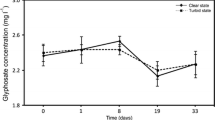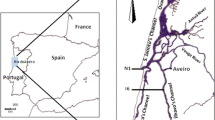Abstract
Moderately saline soda lakes harbor extremely abundant and fast growing bacterial communities. An interesting phenomenon of an explosive bacterial growth in shallow soda lakes in Eastern Austria after dilution with rainwater, concomitantly with a significant decrease in temperature was observed in a former study. In the present study, we tried to identify the factors being responsible for this enhanced bacterial growth in laboratory batch cultures. Three experiments were performed with water taken from two different lakes at different seasons. Natural soda lake water was diluted with distilled water, artificial lake water, sterile filtered soda lake water, and grazer-free water to test (1) for the influence of compatible solutes released to the environment and reduced salt stress after osmotic down-shock, (2) for the influence of nutrients, which may be washed in from the dry areas of the lake bottom after rainfall and (3) for the decrease of grazing pressure due to dilution. The potential influence of (4) viruses was indirectly deduced. The response of the bacterial community to the manipulations was measured by changes in bacterial numbers, the incorporation of 3H-leucine and the concomitant determination of the amount of 3H-leucine uptaking bacteria by microautoradiography. The influence of the environmental factors enhancing bacterial growth after a simulated rainfall event showed variations between the lakes and over the seasons. The addition of nutrients was, in all experiments, the main factor triggering bacterial growth. The decrease in grazing pressure and viral lysis after dilution was of significant importance in two of three experiments. In the experiment with the highest salinity, we could show that either compatible solutes released after osmotic down-shock and used as a source of nutrients for the soda lake bacterial populations or reduced salt stress were most probably responsible for the observed marked enhancement of bacterial growth.







Similar content being viewed by others
References
Ajouz B, Berrier B, Garrigues A, Besnard M, Ghazi A (1999) Release of thioredoxin via the mechanosensitive channel MscL during osmotic downshock of Escherichia coli cells. J Biol Chem 273:26670–26674
Boon PI (1991) Bacterial assemblages in rivers and Billabongs of south-eastern Australia. Microb Ecol 22:27–52
Bremer E, Krämer R (2000) Coping with osmotic challenges: osmoregulation through accumulation and release of compatible solutes in bacteria. In: Stroz, G, Hengge-Aronis, R (eds.) Bacterial Stress Responses. ASM Press, Washington DC
Carpenter SR (1996) Microcosm experiments have limited relevance for community and ecosystem ecology. Ecology 77: 677–680
Chen F, Lu JR, Binder BJ, Liu YC, Hodson RE (2001) Application of digital image analysis and flow cytometry to enumerate marine viruses stained with SYBR gold. Appl Environ Microbiol 67:539–545
Coveney MF, Wetzel RG (1992) Effects of nutrients on specific growth rate of bacterioplankton in oligotrophic lake water cultures. Appl Environ Microbiol 1:150–156
Drake J, Huxel G, Hewitt C (1996) Microcosms as models for generating and testing community theory. Ecology 77:670–677
Eiler A, Farnleitner AH, Zechmeister TC, Herzig A, Hurban C, Wesner W, Krachler R, Velimirov B, Kirschner AKT (2003) Factors controlling extremely productive heterotrophic bacterial communities in shallow soda pools. Microb Ecol 46:43–54
Felip M, Pace ML, Cole JJ (1996) Regulation of planctonic bacterial growth rates: the effects of temperature and resources. Microb Ecol 31:15–28
Fischer UR, Velimirov B (2002) High control of bacterial production by viruses in a eutrophic oxbow lake. Aquat Microb Ecol 27:1–12
Flood JA, Ashbolt NJ (2000) Virus sized particles can be entrapped and concentrated one hundred fold within wetland biofilms. Adv Environ Res 3:403–411
Grant WD, Jones BE, Mwatha WE (1990) Alkaliphiles: ecology, diversity and applications. FEMS Microbiol Rev 75:255–270
Kiefer DA, Berwald J (1992) Limnology and oceanography. Limnology and Oceanography 37:457–467
Kilham P (1981) Pelagic bacteria: extreme abundances in African saline lakes. Naturwissenschaften 68:380–381
Kirchman D, K’Nees E, Hodson R (1985) Leucine incorporation and its potential as a measure of protein synthesis by bacteria in natural aquatic systems. Appl Environ Microbiol 49:599–607
Kirchman DL, Ducklow HW (1993) Estimating conversion factors for the thymidine and leucine methods for measuring bacterial production. In: Kemp, PF, Sherr, BF, Sherr, EB, Cole, JJ (eds.) Handbook of Methods in Aquatic Microbial Ecology. Lewis Publishers, Boca Raton, FL pp 513–517
Kirisits MJ, Parsek MR (2006) Does Pseudomonas aeruginosa use intercellular signalling to build biofilm communities? Cell Microbiol 8:1841–1849
Kirschner AKT, Velimirov B (1999) Benthic bacterial secondary production measured via simultaneous 3H-Thymidine and 14C-Leucin incorporation, and its implication for the carbon cycle of a shallow macrophyte-dominated backwater system. Limnol Oceanogr 44:1871–1881
Kirschner AKT, Eiler A, Zechmeister TC, Velimirov B, Herzig A, Mach R, Farnleitner AH (2002) Extremely productive microbial communities in shallow saline pools respond immediately to changing meteorological conditions. Environmental Microbiology 4:546–555
Kirschner AKT, Wihlidal P, Velimirov B (2004) Variability and predictability of the empirical conversion factor for converting 3H-thymidine uptake into bacterial carbon production for a eutrophic lake. Journal of Plankton Research 26:1559–1566
Koropatkin NM, Koppenaal DW, Pakrasi HB, Smith TJ (2007) The structure of a cyanobacterial bicarbonate transport protein, CmpA. J Biol Chem 282:2606–2614
Krachler R, Krachler R, Milleret E, Wesner W (2000) Limnochemische Untersuchungen zur aktuellen Situation der Salzlacken im Burgenländischen Seewinkel. Burgenländische Heimatblätter 62:3–49
Maranger R, Bird DF (1995) Viral abundance in aquatic systems: a comparison between marine and fresh waters. Mar Ecol Prog Ser 121:217–226
Morris DP, Lewis WM (1992) Nutrient limitation of bacterioplankton growth in Lake Dillon, Colorado. Limnol Oceanogr 37:1179–1192
Murray AG, Jackson GA (1992) Viral dynamics: a model of the effects of size, shape, motion and abundance of single-celled planktonic organisms and other particles. Mar Ecol Prog Ser 89:103–116
Norland S (1993) The relationship between biomass and volume of bacteria. Current Methods in Aquatic Microbial Ecology 303–307
Pace ML, Cole JJ (1994) Comparative and experimental approaches to top–down and bottom–up regulation of bacteria. Microb Ecol 28:181–193
Pomeroy LR, Wiebe WL (2001) Temperature and substrate as interactive limiting factors for marine heterotrophic bacteria. Aquat Microb Ecol 23:187–204
Posch T, Loferer-Krößbacher M, Gao G, Alfreider A, Pernthaler J, Psenner R (2001) On the precision of bacterioplankton biomass determination: a comparison of two fluorescent dyes and of allometric and linear volume-to-carbon conversion factors. Aquat Microb Ecol 25:55–63
Pulido-Villena E, Reche I (2003) Exploring bacteriplankton growth and protein synthesis to determine conversion factors across a gradient of dissolved organic matter. Microb Ecol 46:33–42
Simek K, Hornak K, Masin M, Christaki U, Nedoma J, Weinbauer MG, Dolan JR (2003) Comparing the effects of resource enrichment and grazing on a bacterioplankton community of a meso-eutrophic reservoir. Aquat Microb Ecol 31:123–135
Simon M, Azam F (1989) Protein content and protein synthesis rates of planktonic marine bacteria. Mar Ecol Prog Ser 51:201–213
Smith LT, Pocard JA, Bernard T, Le Rudulier D (1988) Osmotic control of glycine betaine biosynthesis and degradation in Rhizobium meliloti. J Bacteriol 170:3142–3149
Toolan T, Wehr ID, Findlay S (1991) Inorganic phosphorus stimulation of bacterioplankton production in a meso-eutrophic lake. Appl Environ Microbiol 57:2074–2078
Vaque D, Pace ML (1992) Grazing on bacteria by flagellates and cladocerans in lakes of contrasting food-web structure. J Plankton Res 14:307–321
Welsh DT (2000) Ecological significance of compatible solute accumulation by micro-organisms: from single cells to global climate. FEMS Microbiol Rev 24:263–290
White PA, Kalff J, Rasmussen JB, Gasol JM (1991) The effect of temperature and algal biomass on bacterial production and specific growth rate in freshwater and marine habitats. Microb Ecol 21:99–118
Wieltschnig C, Wihlidal P, Ulbricht T, Kirschner AKT, Velimirov B (1999) Low control of bacterial production by heterotrophic nanoflagellates in a eutrophic backwater environment. Aquatic Microbial Ecology 17:77–89
Wieltschnig C, Kirschner AK, Steitz A, Velimirov B (2001) Weak coupling between heterotrophic nanoflagellates and bacteria in a eutrophic freshwater environment. Microb Ecol 42:159–167
Wieltschnig C, Kirschner AKT, Fischer U, Velimirov B (2003) Top–down control of benthic heterotrophic nanoflagellates by oligochaetes and microcrustaceans in a littoral freshwater habitat. Freshw Biol 48:1840–1849
Wommack KE, Colwell RR (2000) Virioplankton: viruses in aquatic ecosystems. Microbiol Mol Biol Rev 64:69–114
Wood JM, Bremer E, Csonka LN, Kraemer R, Poolman B, van der Heide T, Smith LT (2001) Osmosensing and osmoregulatory compatible solute accumulation by bacteria. Comp Biochem Physiol A Mol Integr Physiol 130:437–460
Zar JH (1974) Biostatistical Analysis, Prentice Hall, Englewood Cliffs, NJ
Zinabu GM, Taylor WD (1997) Bacteria–chlorophyll relationships in Ethiopian lakes of varying salinity: are soda lakes different? J Plankton Res 19:647–654
Acknowledgements
Many thanks to Claudia Nemecz-Wieltschnig for substantial help in protozoan direct counting. Thanks also to the staff of the “Biologische Station Neusiedlersee” (Peter Gisch and Jutta Prückler) for the chemical analyses of the soda lake water. The project was financed by ENVIRO OEG, Eisenstadt, the Province of Burgenland (Project LW 621) and the Austrian “Naturschutzbund”.
Author information
Authors and Affiliations
Corresponding author
Rights and permissions
About this article
Cite this article
Krammer, M., Velimirov, B., Fischer, U. et al. Growth Response of Soda Lake Bacterial Communities to Simulated Rainfall. Microb Ecol 55, 194–211 (2008). https://doi.org/10.1007/s00248-007-9267-5
Received:
Accepted:
Published:
Issue Date:
DOI: https://doi.org/10.1007/s00248-007-9267-5




